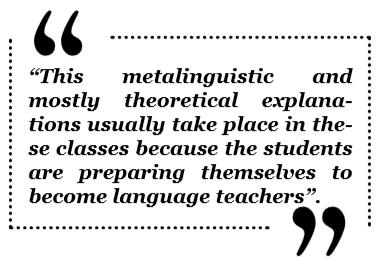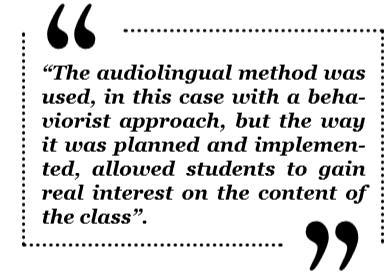
5 minute read
Experiencia
Advertisement
Carlos Álvarez
Estudiantes Licenciatura en Lenguas Modernas
Juan Obando
Nowadays, academics are changing how the concepts of both teaching and learning are defined in a general matter. Consequently, it is possible to see how the concepts (and evidently the role) of the teacher and the student are changing too. Some revolutionary methodologies, like the post-method, are gaining more popularity every day. This one shows how there is a huge difference between the theory and the actual teaching practice, it also proposes and develops new practices for SLT/ FLT. Moreover, some old practices keep getting strongly criticized by these new ones, making them look obsolete and keeping them unused by SL/Fl teachers. This is the result of the evolution of almost every aspect of human reality, but some of these forgotten “methods” can be transformed and have better results in practice.
Some of the most controversial practices are activities based on rewards. In fact, they are criticized because they follow what
Image: bit.ly/2CyCYeA
the theory of Skinner proposed. Behaviorism is one of these classic practices that leads students to knowledge through; it is labeled as primitive approach to language teaching due to the focus that it has on stimuli; reinforcements and punishments given to good and bad behaviors respectively. It really doesn’t sound as a promising strategy, for today’s standards and most authors of newer methods and methodologies question its results. However, when an activity and its methodologies are adapted to a specific context and considers what the students’ needs are, the results seem to be different in a very positive way. For example, in a French class of 25 Colombian students at Pontificia Universidad Javeriana, a competition was made to encourage the students to improve their pronunciation. First, the teacher asked the students if they wanted him to play music for them to hear while they completed the activities of the class. Then, after the students accepted, the teacher played some French music and he let it play throughout the whole activity. Once the classroom was set, the teacher explained briefly how the Enchainement consonantique et vocalique works. He used authentic audio material to ensure that he was indeed providing the class with

comprehensive input. The teacher then used this authentic material he had brought, to demonstrate how the Enchainement takes place in French phonetics. This metalinguistic and mostly theoretical explanations usually take place in these classes because the students are preparing themselves to become language teachers; therefore, making them conscious about language formalities and specific details is an actual need. After that, the activity began, and they were instructed to pick partners, but they had to be with people whom they were not used to work with. They had to read loudly a sentence written on the board and pronounce it the best they could, so the group that pronounced the sentence the best earned a point for the group, every single sentence applied for the case of Enchainement that they had just reviewed. Although at the beginning they seemed not to like the activity, at the end they were surprisingly encouraged to do better than their contenders.
The students were so focused and interested in beating the opposite team that they were working with their new partners with incredible ease, and they were also doing a great effort to improve their pronunciation, which is what ultimately would have won them the game. Another good aspect that can be noticed is the fact that those, who were divided from their partners, were more eager to actively participate in the acti-

vity, when their workmates had done the same during the activity. Keeping in mind that the usual groups that the students were used to work with can be classified in different level of proficiency, it would be accurate to say that they were able to compete in similar circumstances. In fact, those who were normally shy participated actively in the competition when a friend (now in another team) was placed against them in this game. At the end of the activity, students went back to their usual groups and the class continued as usual. The exercise was a success, even when some of the oldest methods were applied to this activity. The audiolingual method was used, in this case with a behaviorist approach, but the way it was planned and implemented, allowed students to gain real interest on the content of the class. We can certainly state that the goal of the lesson was accomplished, yet the lesson lacked a communicative approach, it was not task based and it included the use of metalanguage explicitly. Looking at the current state of the art methodologies when it comes to teaching French as a foreign language, it seems that this class was going against the current proposals recommended by most authors. However, the results seem to indicate that the methodologies used were accurate and effective. It’s hard to determine if a method is obsolete, especially because every single group of students have different needs that cannot be fulfilled by only one method, or only one approach. The ability to adapt a method to what is currently needed is the key to a successful teaching practice. For example, it may be more accurate to use a method like grammar translation when dealing with true beginners instead of trying to use task based learning or communicative language learning. Having theoretical knowledge about several methods is essential because it allows teachers to be versatile in their teaching practice. It is like gaining an arsenal of tools that can be used for different situations. Hence, no method cannot be called obsolete.










